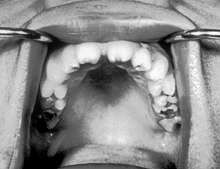Hutchinson teeth
| Classification according to ICD-10 | |
|---|---|
| A50.5 | Other forms of florid late congenital syphilis |
| ICD-10 online (WHO version 2019) | |
As Hutchinson-teeth one is Zahndeformität referred to as a late result of a congenital syphilis is visible. This deformity was first described by Jonathan Hutchinson (1828-1913), a British physician who was active in many fields, but mainly dealt with syphilis as a venereologist .
Hutchinson triad
However, Hutchinson teeth alone are not a clear sign of congenital syphilis, but only the Hutchinson triad , which includes parenchymal keratitis and inner ear hearing loss. The triad can be formed completely or only partially.
Occurrence
In 45–65% of cases, the permanent upper central incisors have a typical barrel shape with a crescent-shaped notch on the tooth edge , in 22–65% of cases the first permanent molars ( six-year-old molars ) are affected, which have a "mulberry-shaped" shape exhibit.
In addition, there are gaps in the set of teeth ( diastemata ), with the teeth often converging towards the center.
These changes can be made visible as an anomaly of the respective tooth system by means of an X-ray before the tooth eruption .
These tooth changes can also occur in the context of rare syndromes , e.g. B. in Nance-Horan syndrome .
Differential diagnosis
In the differential diagnosis, rachitic teeth are to be delineated, which are mostly vertical and have enamel defects.
See also
Web links
- Dental knowledge lexicon ; with a photo of the corresponding incisors
- Medical University of Graz, Slide No. 98
Individual evidence
- ^ A b O. Braun-Falco, Gerd Plewig, HH Wolff: Dermatology and Venereology . Springer, 2013, ISBN 978-3-662-00524-8 , pp. 91 ( google.com ).
